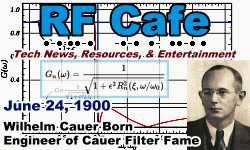|
 June 24 June 24
 1633: The Inquisition released
Galileo Galilei after having ruled him guilty of heresy two days earlier. 1880:
Jules Lissajous, the French mathematician after whom Lissajous
figures are named, was died. 1881: Sir William Huggins made the first photographic spectrum of a
comet. 1900: German mathematician
Wilhelm Cauer,
of filter transfer function fame, was born. 1915:
Sir Fred Hoyle,
the astronomer who coined the term "Big Bang," was born. 1930: The first radar detection
of aircraft took place at Anacostia Air Station, D.C. 1963: The first demonstration
of a home video recorder was made at the BBC News Studios using the
Telcan.
1964: The
Federal Trade Commission announced that starting in 1965, cigarette
manufactures will be required to include warnings on their packaging about the harmful
effects of smoking. 1968: This was the deadline for redeeming
silver certificate dollars for silver bullion. 1969:
Willy Ley, founder
of the German Rocket Society, died. 1975: A moon tremor, caused by a strike of Taurid
meteors, was detected by the seismometer network left on the Moon's surface by Apollo
astronauts. 1997: The U.S. Air Force released a report on the "Roswell Incident," suggesting the alien bodies witnesses reported
seeing in 1947 were actually life-sized dummies. 2012:
Radio Canada International's final shortwave broadcast was made. 1633: The Inquisition released
Galileo Galilei after having ruled him guilty of heresy two days earlier. 1880:
Jules Lissajous, the French mathematician after whom Lissajous
figures are named, was died. 1881: Sir William Huggins made the first photographic spectrum of a
comet. 1900: German mathematician
Wilhelm Cauer,
of filter transfer function fame, was born. 1915:
Sir Fred Hoyle,
the astronomer who coined the term "Big Bang," was born. 1930: The first radar detection
of aircraft took place at Anacostia Air Station, D.C. 1963: The first demonstration
of a home video recorder was made at the BBC News Studios using the
Telcan.
1964: The
Federal Trade Commission announced that starting in 1965, cigarette
manufactures will be required to include warnings on their packaging about the harmful
effects of smoking. 1968: This was the deadline for redeeming
silver certificate dollars for silver bullion. 1969:
Willy Ley, founder
of the German Rocket Society, died. 1975: A moon tremor, caused by a strike of Taurid
meteors, was detected by the seismometer network left on the Moon's surface by Apollo
astronauts. 1997: The U.S. Air Force released a report on the "Roswell Incident," suggesting the alien bodies witnesses reported
seeing in 1947 were actually life-sized dummies. 2012:
Radio Canada International's final shortwave broadcast was made.
| Jan
| Feb | Mar |
Apr | May |
Jun | Jul |
Aug | Sep |
Oct | Nov |
Dec |
Note: These
historical tidbits have been collected from various sources, mostly on the Internet.
As detailed in
this article, there
is a lot of wrong information that is repeated hundreds of times because most websites
do not validate with authoritative sources. On RF Cafe, events with
hyperlinks have been verified. Many years ago,
I began commemorating the birthdays of notable people and events with
special RF Cafe logos.
Where available, I like to use images from postage stamps from the country where
the person or event occurred. Images used in the logos are often from open source
websites like Wikipedia, and are specifically credited with a hyperlink back to
the source where possible.
Fair Use laws permit
small samples of copyrighted content.
|








 June 24
June 24
